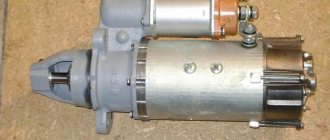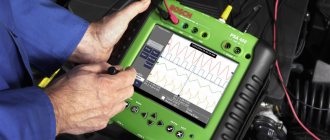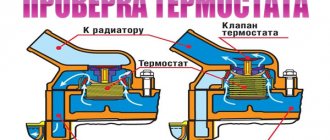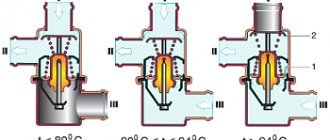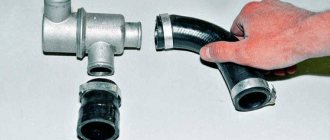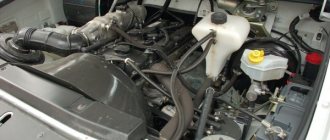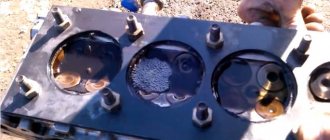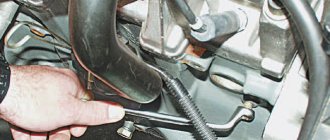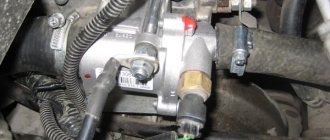The thermostat is responsible for maintaining the optimal temperature of the car engine. It allows you to timely switch the levers for moving cooling antifreeze or distilled water in a small and large circle. Turning on the thermostat is always accompanied by the fastest possible warm-up of the massive engine; the unit includes both the engine and the stove.
After the temperature reaches optimal values, it is sent to a large circuit, which includes the radiator. If the temperature regime is chosen correctly and economically, the engine will last longer.
If the condition of the thermostat leaves much to be desired, there are breakdowns, the engine will constantly gain high temperatures, it is possible to increase the fuel consumption of the VAZ-2110.
Methods for checking the health of the thermostat
If the driver detects one of the above malfunctions, he will have to check the serviceability of the thermostat. At the same time, there are two ways to check this device: with removal from the car and without removal. Let's talk about each method in more detail.
Checking the device without removing it from the car
This is the simplest option that every car enthusiast can handle. The main thing is that the engine is completely cold before starting the test.
The engine starts and idles for 20 minutes
During this time, the antifreeze will heat up properly, but it will not yet enter the radiator. After 20 minutes, carefully touch the upper thermostat tube with your hand. If it is cold, it means that the antifreeze circulates in a small circle (that is, it enters only the engine cooling jacket and the small stove radiator)
That is, the thermostat valve is still closed, and in the first 20 minutes of operation of a cold engine this is normal.
If the upper tube is so hot that it is impossible to touch it, then the valve is most likely jammed. Or it has lost its tightness and stopped responding adequately to temperature changes.
If the upper thermostat tube heats up, but it does so very slowly, this indicates that the central valve is not fully opening. Most likely, it is stuck in the half-open position, which in the future will lead to difficult starting and a very long warm-up of the engine.
Checking the device by removing it from the car
Sometimes it is not possible to check the serviceability of the thermostat using the above method. Then there is only one way out: remove the device and check it separately.
- First you need to wait until the car engine has completely cooled down. After this, all the antifreeze is drained from the car (it is best to drain it into a small basin, having first completely unscrewed the cap from the expansion tank).
- The thermostat is supported by three pipes, which are attached to it using steel clamps. These clamps are loosened with a regular flat-head screwdriver and the pipes are removed manually. After this, the thermostat is removed from the engine compartment of the “Seven”.
- The thermostat removed from the car is placed in a pan of water. A thermometer is also placed there. The pan is placed on the gas stove. The water gradually warms up.
- All this time you need to monitor the thermometer readings. When the water temperature reaches 90°C, the thermostat valve should open with a characteristic click. If this does not happen, the device is faulty and needs to be replaced (thermostats cannot be repaired).
Basic thermostat malfunctions
The thermostat is a fairly simple device that rarely fails. If you have problems with your thermostat, they are most often associated with the following reasons:
- The valve for switching the liquid circulation from a large to a small circle has stopped closing tightly. Because of this, immediately after starting the engine, antifreeze circulates in a complete large circle, which is why warming up to an operating temperature of 90 degrees Celsius takes many times longer than with a working thermostat;
- The fluid circulation switch valve is stuck closed. In such a situation, the sensor to open it is triggered, but the damper cannot move. This leads to the fact that the antifreeze continues to circulate in a small circle even after the engine has warmed up. Accordingly, the engine parts do not receive the necessary cooling, and it overheats.
The thermostat is not expensive, but it is not to blame for all problems with engine cooling. That is why, before replacing the thermostat, you need to make sure that it is faulty.
The first way to check the serviceability of the VAZ-2115 thermostat
To make sure that the thermostat element of the vehicle's cooling system is in good or bad condition, you will need to perform the following steps:
- Start the car engine.
- Warm up the car for 10 minutes.
- Open the hood lid.
- Check by touch the radiator pipes - upper and lower:
- with a working thermostat element, the hot pipes are at the same temperature;
- if the thermostat is faulty (the valve is stuck in a closed or intermediate position), the pipes will overheat because the coolant circulates in a small circle.
As you can see, such a tactile testing method will not cause difficulties even for a novice car enthusiast.
How to identify a malfunction
You can determine whether the VAZ-2110 thermostat needs to be replaced on your own.
To do this, start and warm up the car engine to operating temperature at idle speed. Next, in the engine compartment, find the radiator pipes. Touch them. If the device is working, they should both be hot. This is evidence that the coolant circulates freely in the system.
If one of them turns out to be cold, it means that the valve did not open and the thermostat did not work. But this does not mean that it needs to be changed immediately. For the VAZ-2110, replacement of the thermostat will be required only if its entire structure turns out to be unsuitable for further operation. In other cases, you can get by with repairing it.
The principle of operation of the thermostat on the VAZ 2114
The constituent structure of the thermostat is a fairly simple mechanism that is suitable for distributing the movement of liquid over small and large cooling circles (this depends on the supply temperature).
Thermostat: 1 – inlet pipe (from the radiator); 2 – rubber insert; 3 - solid heat-sensitive filler; 4 – bypass valve spring; 5 – inlet pipe (from the engine); 6 – bypass valve; 7 - outlet pipe (to the pump); 8 - main valve spring; 9 - main valve; 10 – pipe (from the expansion tank); 11 – piston.
A simple standard class 2114 thermostat, which is installed directly at the factory, consists of the following types of spare parts:
Thermostat device
- frame;
- bypass valve spring;
- bypass valve;
- main valve spring;
- main valve;
- pipes;
- piston with holder;
- temperature sensitive element.
Thermostat operating principle
- The temperature-sensitive element gives a signal to start the operation of this thermostat.
- If the main valve is closed, then after the motor starts running, the liquid in the system heats up and begins to move in a smaller circle.
- The liquid passes through the thermostat device and heats the sensitive element (it promotes expansion, thereby causing pressure on the valve).
- When the coolant is heated to the desired point (87 degrees), the valve begins to open little by little, and the coolant is gradually placed in a larger circle.
- If the heating of the coolant reaches 102 degrees, the valve will open completely and the fluid will circulate through the radiator.
- Consequently, after the machine’s engine stops operating, the liquid will begin to cool, and the temperature-sensitive element will compress and the valve will return to its initial position due to the return spring.
- It may happen that due to wear or damage (in extreme cases, factory defects), the VAZ 2114 thermostat becomes stuck in some position.
- Accordingly, the car engine may take a very long time to warm up, or, on the contrary, the engine overheats, which is a dangerous sign.
- Overheating of the motor can lead to massive damage, even self-destruction of the engine. In this case, major repairs will have to be carried out.
SIGNS AND CONSEQUENCES OF A MALFUNCTION
What consequences should you prepare for if you failed to check the functionality of the thermostat in time?
- Poor performance of the car interior heater. If the valve is stuck open, coolant constantly circulates through a large circuit. Cooling of the radiator by the flow of incoming air and a general increase in the surface area that gives off heat leads to constant underheating of the engine. Because of this, not only does the stove heat poorly, but also the power decreases and fuel consumption increases.
- Motor overheating. A short-term excess of operating temperature can only lead to overheating of the piston rings, due to which their elasticity is lost. This will subsequently lead to loss of compression and increased oil consumption. Long-term operation in overheating mode is fraught with breakdown of the cylinder head gasket, thermal deformation of the cylinder head, loss of elasticity of the valve stem seals, and scuffing of the cylinder-piston group. As you understand, it is much easier to check the thermostat yourself than to pay for a major engine repair. If the cap of the expansion tank is faulty or cannot cope with the increased pressure in the cooling system, the tank may crack and the integrity of the radiator will be compromised in previously damaged areas.
Ways to check an element
You can check the operation of the thermostat yourself directly in the car. In the vast majority of cases, such diagnostics give reliable results. You need to start checking when the engine has completely cooled down: start it and periodically feel the lower part of the radiator and the pipe extending from the bottom back to the engine.
The serviceability of the thermostat is determined by the following signs:
- at the initial stage of warming up, the radiator and the pipes suitable for it are completely cold;
- at an antifreeze temperature of 40–60 °C, the upper supply hose begins to warm up, the lower one remains cold;
- when the antifreeze heats up to 90–95 °C, the entire area of the heat exchanger and the lower pipe become hot, which indicates the opening of the damper and the movement of liquid along a large circuit.
It is recommended to carry out diagnostics until the sensor is triggered and the fan automatically turns on.
Deviations from the norm are interpreted as follows:
- If the inlet and outlet pipes together with the radiator immediately warm up, the thermostat is stuck in the open position. Antifreeze initially flows in a large circle, hence the heating.
- When the temperature reaches 90 °C, the bottom of the heat exchanger and the outgoing hose remain cold - the thermoelement damper is tightly closed, the part has become unusable.
- When the top of the radiator is hot and the bottom is slightly warm, the thermostat is stuck half-closed.
Unlike the first two points, the last conclusion requires mandatory confirmation. It is quite difficult to make a clear diagnosis when the coolant is divided into two streams moving along different circuits. Uneven heating of the heat exchanger fins, turning on of the fan and temperature surges are indirect signs. Symptoms of an air lock in the cooling system appear similarly.
To clearly check the functionality of the thermostat, it will have to be removed from the car. Disassembly and diagnostics are performed in the following order:
- Let the engine cool and drain the antifreeze - first from the cylinder block, then from the radiator. It is more convenient to empty the system into a wide container with low sides.
- Loosen the clamps securing the pipes to the thermostat. Disable them and remove the element.
- Inspect the part for a slightly open damper. If a malfunction is detected, further checking is pointless - you need to buy and install a new spare part.
- Heat a pan of water on the stove. When its temperature approaches boiling, lower the thermostat into the container and watch the damper. It should open without delay.
- Remove the part from the pan. When cooled, the thermoelement should immediately close the passage.
If during the inspection it turns out that the damper does not work or is jammed, the part must be replaced, since it cannot be repaired. Considering the large number of fakes on the auto parts market, you can first test a new thermostat in a store. Close the outlet pipe with your finger and try to blow air through the inlet pipe. A hermetically sealed damper will prevent this from happening.
Retest the new part at home by immersing it in a pan of boiling water. If the heat-sensitive mechanism does not work, return the defective part to the store or exchange it for another one.
How to check the thermostat
To fully check the thermostat and identify absolutely any of its malfunctions, it is enough to know only three methods. Two of them allow you to carry out diagnostics without draining the coolant or disassembling anything. Let's start with them.
Checking the thermostat with bare hands
All you need to check the thermostat using this method is a working engine temperature gauge on the instrument panel. By observing its behavior, you can promptly identify almost all of the malfunctions described above. Naturally, you cannot do without understanding how the cooling system in general, and the thermostat in particular, works.
The algorithm is like this:
- While the engine is warming up, the temperature does not rise for a long time - the thermostat is either not completely closed, or it is completely stuck open.
- The temperature almost never reaches normal - the thermostat either opens early or is always open.
- The arrow goes off scale - it is obvious that the thermostat is not working. It is either stuck closed or is starting to close too early.
The disadvantage of this method is, of course, the low diagnostic accuracy. In particular, you need to remember that the temperature going through the roof does not always indicate a broken thermostat. The engine may overheat for other reasons. For example, the main radiator is dirty, the fan is not working, the coolant level is low, or there is air in the system.
Checking the thermostat with thermometers
Second way. Its use allows you to check the thermostat with high accuracy without removing it from the car. As the name suggests, you will need thermometers. And those that can be attached to the car’s cooling system. In addition, the measuring range of the instruments must be at least up to +150°C. The most convenient tool for these purposes is a multimeter with a thermocouple and a corresponding function. A kitchen thermometer, if available, will also work.
The algorithm for checking the thermostat with thermometers is as follows:
- Initially, the engine should be cold.
- The first thermocouple is attached to the branch pipe of the small circuit of the cooling system closer to the thermostat. Be sure to ensure that the surrounding air does not introduce errors. Therefore, you should wrap the thermocouple with electrical tape.
- The second one is wound on the other side. That is, between the thermostat and the main radiator. Closer to the first one.
- We start the engine and watch the temperatures before and after the thermostat.
- We draw appropriate conclusions about its performance based on the information presented above.
Here is an example for clarity. Let's say you are warming up a cold engine, and the temperature goes up on two devices at once. This clearly indicates that the thermostat is stuck open. If it is working properly, then the small circuit should warm up, and the large circuit should remain almost cold until the motor reaches operating temperature. When it is reached, the temperature in the large circuit should begin to rise, and in the small circuit it should fluctuate back and forth.
Checking the thermostat in boiling water
A folk method, one might say. Simple, clear and accurate. The only drawback is that the thermostat must be removed from the car to check. In addition, you will need a container of water, a stove and a thermometer to measure the temperature of liquids. As a matter of fact, if the thermostat is stuck in some position, then you will understand it immediately after disassembly. That is, there will be no need to check anything in boiling water. If visually everything looks functional, we proceed to the test.
The algorithm is like this:
- Secure the thermostat in a container of water so that it is completely immersed in it, but does not touch the walls or bottom.
- Similarly, install a thermometer in the water.
- Heat the water until the thermostat begins to open slightly.
- Record the water temperature.
- Heat until boiling.
- Note the temperature at which the thermostat opened fully.
- Check the resulting numbers either with the inscriptions on the thermostat itself or with the instruction manual for your car.
It is clear that this method allows you to accurately identify all thermostat malfunctions, including late or early operation.
Indicators of thermostat malfunction
Clear indicators of a thermostat malfunction are:
- prolonged warming up of the engine to operating temperature, and its rapid overheating;
- the engine temperature arrow drops at speeds below normal and rises when the car stops;
- the lower pipe is warm after a few minutes of warming up the engine: this indicates that the thermostat is open all the time;
- The thermostat is stuck in the closed position, the engine is boiling, but the lower pipe remains cold, even when the engine is warm
Required reading:
- How to determine the real mileage of a car
- European protocol for road accidents in 2015
- How is a traffic police report on an administrative offense required to be drawn up and filled out?
- What to do if the Check Engine light comes on?
- What should you do when a traffic violation report is drawn up against you?
- Car antennas for TV
- Liquid rubber for a car: its pros, cons, use
Types of VAZ thermostats and which one is better
Visually, even an experienced salesman cannot distinguish a kopek thermostat from a Niv one. Because the difference is inside them and in the location of the pipes. All Togliatti thermostats are made according to the ancient Fiat design - they are removed from the cylinder head into a separate unit and fixed to the pipes and hoses of the cooling system. Here are the main types of VAZ thermostats:
All classic Zhigulis had a 2101 thermostat under the hood, which can be identified by the location of the pipes; they are turned opposite each other almost at a right angle
However, the most important difference is that the thermal operating mode of rear-wheel drive Zhiguli engines required blocking the valve at 80 degrees and fully opening it at an antifreeze temperature of 95 degrees
Exactly the same device was and is being installed on the Niva. The only difference is that the angle between the pipes tends to 180 degrees.
Thermostat VAZ 21213, 21214 (Niva)
The eight thermostat is installed on all carburetor Samaras in their countless modifications. The difference with classic motors in terms of thermoregulation is that in thermostat 2108 the valve should operate seven degrees later. This happened due to the more advanced design of the combustion chamber, so until the antifreeze temperature reaches 87 degrees, the valve should be closed, and only at 102 degrees should it open.
Modern thermostats on the spare parts market are not distinguished by high accuracy and high quality workmanship, so after a series of tests the plant gave two degrees to the manufacturers. As a result, on boxes with thermostats for the entire Samara family, you can often see the number 85. Visually, the 2108 thermostat is distinguished by the presence of a thin pipe to remove possible air bubbles.
The tenth VAZ family received exactly the same thermostat housing as on the classic, but in a mirror image. It does not have a small pipe for air outlet, since the design for the carburetor tens provided a separate tee, which greatly complicated the decoupling of the hoses under the hood. By the way, the figure-eight device is also perfect for carburetor tens; the only thing you need to do is tightly plug the small air hole.
Such thermostats have become the most popular, so when purchasing them, you should definitely look inside; there should be a curtain made of plastic or metal, which better redistributes the flow of liquid to the thermoelement. If it is not there, the valve response temperature can differ greatly (up to 10-15 degrees) from the nominal value, which leads to engine overheating.
Purpose and design of the VAZ-2107 thermostat
In the engine cooling system, the thermostat is installed at the intersection of the pipes from the engine and radiator to the pump. After starting the engine when cold, the thermostat is closed - it blocks the passage from the radiator when it is completely open from the engine. The coolant circulates in a small circle through the cylinder block and pump, which ensures quick warm-up of the engine. When the antifreeze temperature reaches values close to the operating temperature (for a VAZ-2107 with a carburetor 80.6–81.5 °C), the main thermostat valve begins to open, freeing the passage of the pipe from the radiator, and at the same time the bypass valve begins to block the flow of antifreeze from the engine. The pump also begins to “drive” the antifreeze in a large circle: cylinder block, radiator, thermostat, pump. When the antifreeze temperature reaches operating values (for VAZ-2107 94 °C), the thermostat opens completely:
- the pipe from the engine is completely blocked;
- from the radiator is completely open.
Antifreeze circulates only in a large circle. When cooling the antifreeze, the reverse process occurs.
The VAZ-2107 temperature regulator, regardless of the engine type (with injector or carburetor), has the following design:
- non-separable cylindrical body with three pipes;
- directly the thermostat itself.
What engines does the VAZ 2110 come with?
The VAZ-2110 car has been produced since 1996. At the same time, the power part gradually underwent changes:
- 21100 - base model produced in 1996-2000. The car was equipped with an engine with 8 valves and a volume of 1.5 liters (power 69 hp);
- 21101 is a model produced since 2004. Engine - injection, 1.6 liters, 8 valves;
- 21102 - 8-valve engine, 1.5 liters, injector;
- 21103 - 16-valve unit, 1.5 liters, injector.
- 21103 M - 16-valve engine, 1.5 liters, injector (produced since 2002);
- 21104 - 16-valve engine, 1.6 liters, injector;
- 21104M -16-valve engine, 1.6 liters, produced since 2004;
- 21106 GTI - 16-valve engine, 2.0 liters, 150 hp;
- 2110 “Premier” - 16-valve power unit, volume -1.5 liters;
- 2110 “Consul” - limousine, volume - 1.5 liters;
- 2110-91 - rotary piston engine, 1.3 liters.
Important points
When replacing a thermostat, there are a couple of important nuances that cannot be ignored. Here they are:
- on the latest models of “sevens” (cars 2010 and older), the clamps on the thermostat are not worm-type, but band-type. This means that you won’t be able to remove them with a regular flat-head screwdriver, and to remove them you will have to use a special clamp wrench, which not every car owner has in their garage. If the car owner is the “happy” owner of a thermostat with band clamps, then there is only one way out: go to the store for a tool. A clamp wrench costs about 300 rubles;
- Even after draining the antifreeze from the system, personal protective equipment must not be neglected. Please remember: you cannot completely drain the coolant from the machine. Some part of this liquid will still remain in the thermostat pipes and in the thermostat itself. Taking into account the fact that many car enthusiasts prefer to remove thermostats from below, without leaving the inspection hole, antifreeze can easily get into the driver’s eyes. This, in turn, can lead to serious eye irritation and even blindness. Therefore, you should only change the thermostat while wearing safety glasses and gloves.
So, changing the thermostat on the “seven” is not a difficult task. Preparatory procedures take much more time: cooling the engine and completely draining the antifreeze from the system. Nevertheless, even a novice car owner can cope with these procedures. The main thing is to take your time and strictly follow the recommendations given above.
How to check a car's thermostat
There are two main ways to check a car's thermostat. One of them is carried out without removing the part, but requires a pyrometer, and the second is simpler, but the element will need to be removed from the engine during the test.
Checking the thermostat without removing it from the engine
As you know, the thermostat housing is connected to the upper radiator hose, which is included in a large circle of coolant circulation. Accordingly, with the thermostat working, after starting the engine, the upper radiator hose should remain cold (slightly warm) for some time until antifreeze is released through it.
To check the thermostat without removing it from the engine, get a pyrometer (temperature measuring device). You may come across the opinion that the check should be done without a device, measuring the temperature with your hands, but this is quite dangerous, given the large number of moving parts when the engine is running.
Point the pyrometer at the upper radiator hose and start the engine (cold start). For two or three minus periods, observe the device’s indicators. Next, draw a conclusion about the serviceability of the thermostat according to the following rules:
- The hose was cold for two or three minutes (or its temperature rose slightly), and then quickly warmed up. This indicates that the thermostat is working properly, and it switched the coolant circulation from a small circle to a large circle after the engine has sufficiently warmed up;
- The hose initially warmed up slowly. In this case, we can say that the thermostat is stuck in the open position and the antifreeze does not circulate in a small circle;
- The hose did not begin to warm up quickly after two or three minutes. That is, the thermostat is faulty and it does not switch the coolant circulation from a small circle to a large one.
Important: While checking the thermostat, monitor the engine temperature on the instrument panel. If the thermostat is stuck and does not switch the coolant to a large circle, the engine will begin to overheat, which can lead to the failure of expensive parts
Checking the thermostat in the pan
A widespread and well-known way to test the thermostat yourself is using a saucepan. As you might guess, before diagnostics you will need to remove the thermostat from the car engine and bring it home. After this, do the following:
- Take a pot and fill it with water;
- Inspect the thermostat housing and read the technical information on it, which indicates at what temperature it should switch;
- Hang the thermostat in the pan so that it is immersed in water, but does not touch the walls and bottom of the container, that is, it comes into contact only with water;
- Start heating the water and put a regular thermometer in it to measure the temperature of the liquid;
- When the water approaches the thermostat switching value from closed to open, make sure this happens. Also compare the thermometer reading, recording the temperature at which the coolant circuit switching valve opens with the ideal values indicated on the device body.
If the valve opens when heating water, track its behavior when cooling the liquid, checking at what temperature it returns to its original position. Based on the data obtained, draw a conclusion about the functionality of the thermostat.
Why is the thermostat faulty?
The thermostat is a complex electronic device, and it is best to entrust its repair to a specialist.
Let's take a closer look at what problems can occur with the thermostat, and for what reason they appear:
- due to excessive loads, damage to the valve seat: constant flow of coolant through the radiator, the engine warms up longer than usual;
- complete destruction of the temperature-sensitive element of the thermostat due to excessive loads: water gets inside the working element, or wax comes out, which disrupts the correct response to temperature changes;
- opening the valve of the device earlier than usual: the coolant penetrates inside the thermoelement, due to which the volume of heat-sensitive wax increases, which is what the valve is triggered by opening;
- late opening of the thermostat valve: water flows out of the thermoelement body, due to which the working volume of the element decreases, which leads to an increase in temperature for the necessary compensation of the amount of wax;
- at high ambient temperatures, the engine overheats: when the device opens in time, the heated cooling liquid cannot enter the main radiator, but returns back to the engine through the bypass pipe;
- insufficient opening of the thermostat valve, due to which insufficient coolant volume enters the radiator;
- The thermostat valve does not close: there is coolant in the working element, which prevents the valve from completely closing;
- the thermostat is faulty (signs of its malfunction): possible change in the initial settings due to significant overheating of the cooling system;
- The rubber seal of the valve disc is broken: as a result of a malfunction, engine oil has entered the coolant, which dissolves the seal of the thermostat valve.
So, the thermostat in a car is a special valve that regulates the cooling and lubricating flow of the emulsion (coolant) in the car engine. During combustion of fuel, a sufficiently large amount of heat is generated that can cause engine damage. To prevent this, it supplies a mixture of antifreeze and water under the required pressure to the radiator to cool it. The thermostat remains closed until the emulsion reaches the optimal operating temperature, while circulating through the engine without passing through the radiator. And all this happens only in its normal, correct working condition.
To increase the service life of the thermostat, you should change the coolant on time, monitor the appearance of scale on its temperature-sensitive element and carry out preventive maintenance on time.
Thermostat VAZ 2115: Replacement, check where it is located
A thermostat is a sensor designed to maintain a certain temperature. The thermostat blocks the path of antifreeze or any other coolant into the radiator until the engine reaches a certain operating temperature. The operating temperature of the engine is considered to be 90 degrees. The thermostat opens the coolant path at 95 degrees Celsius. Thanks to the thermostat, the engine spends less time warming up to operating temperature. It follows that the thermostat saves your pennies in your pocket and protects the environment. And it is located between the radiator and the engine.
Table of contents
Replacement How to check Which one is better to put Where is it located What does it look like
Replacement
First of all, you need to check whether the thermostat is really not working. We do the following:
1. start the car and feel the lower radiator pipe, it should be cold;
2. wait until the engine warms up to a temperature of 80-85 degrees and feel the pipe again, it should become warm.
Let's move on to the process of removing the thermostat. First, drain the coolant (you can only drain it from the radiator). Now loosen the hose clamps that are attached to the thermostat and remove them.
Then we remove the thermostat from the VAZ 2115.
To check if the thermostat is working, immerse it in water and start heating it; when the water temperature reaches 83-87 degrees, you should see the valve begin to open. If the valve stays still, the thermostat is faulty.
After installing the new thermostat, be sure to refill the coolant.
How to check
It is very easy to check the operation of the thermostat without removing it from the car. It is enough to start the cooled engine and check the temperature of the radiator pipes. In normal mode, when the engine is running, for some time after starting, only the upper radiator pipe will heat up slightly, and when the threshold value is reached, the lower pipe will also heat up sharply. This is evidence of normal valve operation. If heating of both radiator pipes begins simultaneously, this indicates that it is not functioning properly; most likely, the valve is constantly open.
The constantly open thermostat valve allows you to easily reach the nearest service station or spare parts store. It is much worse if the thermostat gets stuck closed, as there is a serious risk of engine overheating. Sometimes tapping on the thermostat body helps for a short time, but if the valve cannot budge, it should be removed or bent with a screwdriver. The thermostat must be replaced in the nearest locality.
Which one is better to put
It will also fit with 099 and 09, and with 083 and 093. It’s not a matter of VAZ models, the fact that components from one model fit another is a normal phenomenon for many manufacturers.
You need to buy a thermostat based on only a few things.
This is the metal from which the thermostat is made; preference should be given to stainless steel,
or brass and the second criterion is not to take Chinese spare parts under any circumstances, even if they are given away for free.
There is no option to check the thermostat while standing at the counter.
Many citizens begin to put pressure on the valve for some reason, apparently they want to check how the “spring” works, but there is no spring there, there is a special spiral made of a special material that operates only at a certain temperature.
If the seller has hot water, then lower the thermostat into the water and check the smooth movement of the rod.
Although, to be honest, it’s unlikely that the seller needs this.
Conclusion: pay attention to the metal first. Secondly to the country of manufacture, VAZ 2115 is a Russian car
Where is
It is located under the air filter housing on injection cars, but on carburetor Samara 2 (namely, the first VAZ 2115 were produced for a couple of years in a carburetor version), it is located exactly there, but the housing on them has simply been moved to a slightly different place, so it is no longer necessary on the carburetor It doesn’t take much trouble to remove the housing, but I just threw off the high-voltage wires and started working, but it doesn’t take long to remove the housing and on the injector it 100% needs to be removed to get to the thermostat, and after the housing is put aside, you will immediately see the thermostat is not armed it will even be visible to the eye (For clarity, it is indicated in the photo below with a red arrow) and next to it there is also a battery (indicated by a blue arrow) so that you understand 100% where it is and do not lose sight of it.
Communities › VAZ 2111 › Blog › Adjustable thermostat, set any temperature!
Today we will talk about a thermostat, a volcano, so to speak, that can sleep, can destroy you, or rather your engine and your pocket, or can peacefully warm you in cold seasons, which some people lack... Many car enthusiasts complain about the poor performance of the stove, it’s not only owners of VAZs, but also owners of foreign cars, trucks and other vehicles.
Of course, before doing this tuning, you need to check the entire ODS system to see if there are other reasons for poor heating of the stove, it could be a pump, an air lock, clogged or homemade radiators, etc. If everything is in order with you, but there is no heat, for example, it will be difficult to “drag” women into such a cold car, they are very heat-loving creatures...) Well, of course, everyone loves warmth, even men, let’s look at how you can do something with a thermostat for free, and you will be warm, and in the summer it will always be possible to return the temperature back. For example, our thermostat on a car of the tenth family has opening properties from 82° to full opening at 85°, but in cold winters, and not very cold ones, our temperature on the highway stays at 82°, precisely at the beginning of its “father” opening. This temperature is certainly not enough for you to feel comfortable and warm. My observations last winter 2022
Gray, don’t heat up the internal combustion engine, but no matter how much you drive to work on the highway, at any time of the day, as soon as the ambient temperature is -5 or lower, well, the engine temperature does not rise above 82°, but you need the heater to blow on your legs and windshield , but there was not enough heat, I had to choose between two evils, of course, it would be “better” with the windshield, so that you could see where you were going, but your feet were constantly freezing... I have done and will do this kind of insulation for the internal combustion engine for the winter, but it heats up quickly, but still holds 82 ° and that’s it... I knew that this was a thermostat, of course, and it starts opening at 82°, every now and then.
And then a colleague wrote this article on copper, there is already a ready-made solution on sale, a full opening at 92°, it begins to open at 88°, well, we argued a little with him, how could it be possible without this, so that the cat would not live too sweetly)) )) Yes! The option is good, but we still need to find it, I live in a place near Moscow, I go there often, but these thermostats are always a bit far from me, and 600 rubles. It's not in my spirit to throw it away. I found a lot of information on the Internet, read everything and about everything, and chose a great option for myself! ... someone will choose my, believe me, not at all a difficult way out.
We drain the coolant from the SOD, remove the thermostat, remove the thermoelement from the thermostat body, I will not describe the principle of its operation, there is information on the Internet.
It turned out exactly 3.5 mm. Moreover, I measured it on the old thermostat housing, the same 3.5 mm.
We measure the thermoelement rod itself.
The result was 3.9 mm. that is, the drilling itself in our case for the thermostat is exactly 4.00 mm.
We take a 2.5 mm drill, and drill very evenly in relation to the axis of the hole itself in the body, then we take a 3.2 mm drill, and with it we will drill the finishing hole that we need for a 4 mm tap. And by the way! Before drilling, center the center so that the drill does not go sideways, this is very important!
We take a 4 mm tap and begin to slowly cut the thread in this hole, carefully, back and forth, without lubrication, the aluminum is soft, we do it gently.
The carving turned out great. By the way, we do not cut the thread to the end where the thermoelement rod itself is inserted, we do not reach it by about 3.5 mm. This is necessary so that the thread does not enlarge the holes for the rod, and it does not begin to dangle more than necessary, although this is not very scary, but We'd better do it well).
The thread was not finished by about 3.5 mm. We find a 4 mm bolt, 30 mm long, preferably a hexagonal head, so that later it will be convenient for you to adjust it with a wrench and not a screwdriver. Unfortunately, I did not find a bolt with such a head, and besides, the head was for a Phillips screwdriver. No problem! We take a grinder and make one cut in one of the crosshairs, and we get an edge for a flat-head screwdriver (-) We screw two more nuts onto this bolt and insert a washer, then a rubber or silicone lining, I cut a piece from the silicone hose of the carburetor octane corrector. But I almost forgot, we lubricate the bolt generously with thermal grease so that, God forbid, it doesn’t turn sour, it turns easily, and our homemade silicone sleeve doesn’t tan or crack.
I used this kind of lubricant, it has proven itself very well absolutely everywhere, even in brake calipers, in the bearings of the pump, generator, everywhere!
We adjust the bolt and measure the depth of the hole for the rod, making it 3.5 mm. as it was according to the standard, and we make these marks for ourselves along the groove of the bolt for a flat-head screwdriver.
The groove for a flat-head screwdriver coincides with the drawn lines; if you want, you can punch it for beauty. We unscrew our bolt exactly half a turn along these lines, and measure the depth of the hole for the rod, I got about 0.3 mm, that is, half a turn of the bolt adjusts the depth of the hole for the rod in one direction or another. Later I unscrewed it, I don’t remember how many half turns, but it turned out to be 4.6 mm. the depth of the hole for the rod, that is, we deepened the hole by 1.1 mm. With this, I began to assemble everything on the internal combustion engine and fill in coolant. I started the engine, warmed it up, and waited for the thermostat to start opening, checking with my hand the lower pipe to the engine cooling radiator until the thermostat opened, when it starts to open, the pipe is warm, and when it opens completely, it is hot. At this moment we control the engine temperature. My thermostat began to open to 82°, as it was according to the standard, at 89-90°. I also checked it on the highway, the temperature did not drop below 88°, this suited me, I liked that I immediately set the temperature to what I needed. And the stove now cooks much hotter, much...)
The temperature can now be adjusted to any temperature, for any time of year, and the most important thing is that I didn’t spend a penny on this tuning of the stove modification =)
Even one degree of heat from the stove in the car’s interior can be felt literally by every fiber, it was 82°, now it’s 88-90°, even my legs and my beloved woman felt the result, let alone the children))))
How to replace the thermostat on a VAZ-2109 with an 8 or 16 valve engine?
This operation should not cause difficulties, and any car owner should be able to handle it, regardless of his experience in the field of car repair. What actions need to be performed are described in this article. The thermostat is a mechanical unit; its operation is based on physical rules. Inside it is wax, which is sensitive to temperature changes. When the coolant is heated, the wax melts and a damper opens, allowing coolant to enter the system, where it is cooled.
Thermostat design VAZ 2109: 1 – inlet pipe from the radiator, 2 – rubber insert, 3 – solid heat-sensitive filler, 4 – bypass valve spring, 5 – inlet pipe from the engine, 6 – bypass valve, 7 – outlet pipe to the pump, 8 – main valve spring, 9 – main valve, 10 – pipe from the expansion tank, 11 – piston.
From the VAZ-2109 to the modern Granta model, thermostats perform their function adhering to one principle, and they are interchangeable with each other. The new unit is smaller in size than the old VAZ models; this fact will not interfere with installing the part from the old VAZ model.
To make the stove heat better, a thermostat from the new VAZ model is installed for this purpose.
Instruction No. 3
Also a popular way to modify the VAZ-2110 thermostat is to reduce the bypass channel. This channel serves to circulate coolant. Experts say: the narrower its diameter, the more antifreeze flows through the heater-stove. And, therefore, the vehicle interior will be warmer. In order to narrow the bypass channel, you must adhere to the following instructions:
- Prepare a thin aluminum plate of a suitable size (several millimeters thick).
- Make a template for the future blank that will be inserted inside the thermostat.
- Cut a plate from an aluminum blank according to the template.
- Secure the new part to the thermostat housing using cold welding or using rivets.
- Drill a hole in the fixed plate - a diameter of 5-6 millimeters (standard hole size is 8 millimeters).
Those who have already made this modification note the following feature: it has become warmer inside the car, but the process of warming up the engine has slowed down somewhat.
Clutch slipping after replacing all its parts
After replacing all elements, adjustment is required, but many car owners ignore this point. The cause is slipping, the car accelerates slowly, the engine speed does not correspond to the speed of the car. The engine just roars, and the car is driving quite slowly, as they say, slipping.
In cars with a mechanical clutch cable, adjustment is made by the cable itself. In hydraulically driven machines, this process is carried out using a clutch rod. In modern cars, you often come across rods that do not have adjustments. But this does not mean at all that it cannot be produced. In such cases, adjustment of the clutch pedal itself is provided, but not everyone knows about this possibility. » alt=»»>
Where is the thermostat located in the car?
A thermostat is a simple valve assembly that separates the circuits of the machine's engine cooling system. In this case, it is triggered automatically, depending on the current heating or cooling of the coolant. The small circuit is the “jacket” of the engine and the radiator built into the cabin, which acts as a stove. The large outline is all of the above plus a large cooling radiator in the front of the engine compartment.
The thermostat is installed on cars so that it is possible to “connect” the main cooling radiator to the small ring. When the power unit heats up under load, the valve gradually opens slightly, and through it part of the hot coolant is discharged into the radiator. There it cools and enters the small ring again. In order for the engine to operate in its most optimal thermal mode, the thermostat maintains operating parameters, opening and closing slightly as needed.
To find the element under the hood, the easiest way is to start from the main radiator. A large cross-section pipe goes from it to the thermostat. Since there are two of them coming out of the radiator, we need the one above. The thermostat itself is usually located in an aluminum housing or directly on the engine itself, where the upper pipe from the main radiator fits. The element itself can be seen only after partial disassembly (including the need to drain the liquid) of the cooling system.
How to replace a thermostat on a Priora
In order for the Lada Priora 16 valves, and any other car model, to work properly and not let the driver down on the road, the car owner must monitor the technical serviceability of the car and promptly repair any breakdowns. If during the next check an antifreeze leak is detected, then you need to first check the thermostat, which will most likely have to be removed and replaced. Replacing a thermostat on a Priora is not a difficult task, so every car owner can cope with such a task, if, of course, this process is carried out according to the instructions provided by professionals in their field.
Replacing the thermostat on a VAZ 2114
How will the replacement of the thermostat on a VAZ 2114 proceed?
It is performed in this order:
- Install the car on a special platform, remove the air filter from under the hood.
- We take out the expansion tank and drain all the liquid present.
- Loosen the cooling system hoses and remove them.
- The nuts that hold the thermostat housing are unscrewed.
- We remove the old thermostat, and if dismantling is difficult, you need to rock it.
- Remove traces of sealant from the specially designated area for the old thermostat and fill in new sealant, placing a gasket on top.
- Next, install the new thermostat and secure its position with nuts.
- We apply a layer of sealant to the pipes of the device, put on the hoses and secure them with clamps.
- After 2 hours, pour new coolant into the system.
- Now we start the engine and monitor the temperature readings to make sure whether the device is working properly or if something needs to be fixed.
Dismantling and replacement
Replacing the thermostat on a VAZ 2110 car will not be difficult, even without the help of specialists. You have checked its functionality and confirmed that it is faulty.
Removal
Removing the thermostat involves performing work in the following sequence:
- Take a screwdriver, an 8 key, a 6 hex key and other tools.
- Make sure the engine is cold. It is strictly prohibited to carry out work on a hot engine.
- Drain the coolant by unscrewing the plug.
- Remove the air filter.
- Locate the clamp on the radiator hose. Loosen it a little, you don't need to remove it completely.
- Disconnect the hose from the thermostat.
- Using the same method, disconnect the coolant pump hose.
- Using a 5mm wrench, unscrew the bolts that secure the thermostat. There are three of them on the VAZ 2110.
- Remove the thermostat cover.
- Remove the thermostat and rubber O-rings from the cover.
Installing a new component
Now let's figure out how to change the old thermostat from a VAZ 2110 to a new one.
As we have already noted, many craftsmen recommend using a thermostat from a VAZ 2111. It is more practical, more reliable, and more compact. Therefore, we offer recommendations for replacement with an eye to using just such a thermostat.
The installation process is not complicated, but it will require some care from you in performing each of the stages:
- First, cut a special tee into the supply hose from the stove. This is necessary because some thermostats have five fittings without access to the expansion tank. And we need six.
- Dismantle the distributor, which will make it easier to complete the following steps. But this is only relevant for a carburetor engine. In VAZ 2110 injection models, skip this step.
- Be sure to mark the position of the distributor relative to the body of the additional units to avoid mistakes during reassembly. Otherwise, you will disrupt the ignition and the engine will not start.
- Remove the tee from the cylinder head.
- Clean the mating plane head from traces of the old gasket.
- Get a new thermostat that fits your vehicle. Muffle the thin heating output using the throttle valve. You won't need it in the future.
- Unscrew the top pin and install a new, longer one in its place.
- Don't be alarmed, the new thermostat is shorter than the old one, the outlet and the pipe do not match. It's not scary. It is necessary to completely dismantle the pipe and put a new one in its place. An element from a VAZ 2112 is perfect. It is also advisable to find a new corner pipe.
- Install a new pipe, do not forget about the gasket.
- Shorten the elbow and screw it into place.
- Replace the standard heater hose with a new one that fits your thermostat.
- Connect the expansion tank, which is specially designed for this purpose, to the fitting.
- Check the quality of each connection so that you don’t have to do all the work again later.
- Fill with new coolant.
- Remove all air from the system.
- Warm up the engine until the fan comes on. To do this, it is necessary to warm up the power unit to approximately 85 degrees.
- If you don’t notice any traces of drops or leaks, it means you replaced the part correctly.
Video
Whether it is difficult or not - decide for yourself. If such a procedure looks problematic for you, it is not recommended to take risks and change the thermostat yourself. Contact a trusted service station and make sure that the technicians use a high-quality new element of the engine cooling system.
To do this, every car owner is recommended to make good connections at trusted service stations. If you treat the craftsmen well, they will do a really high-quality repair. Don't forget how important human relationships are in solving many problems.
